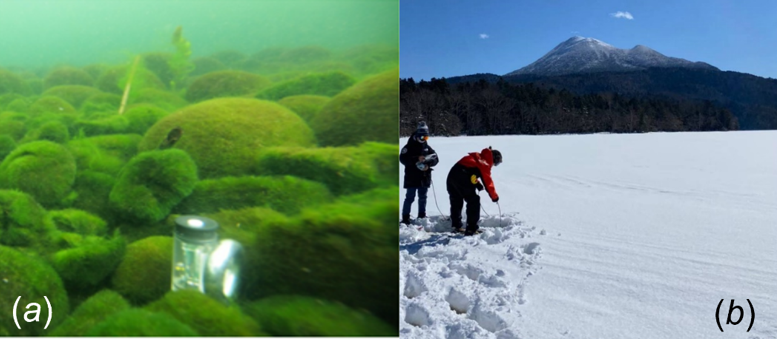高性能計算機シミュレーションにより、酵素やタンパク質の粘着性を最適化するための分子決定要因を明らかにし、多様なバイオテクノロジーへの応用を目指す High-performance computing simulations reveal the molecular determinants for optimizing enzyme or protein stickiness for diverse biotechnological applications
2022-12-23 ロスアラモス国立研究所(LANL)
 Computational simulations carried out by Cesar López and Gnana Gnanakaran, researchers from Los Alamos, provided a framework to understand and interpret the findings from this analytical kit. The atomistic simulations explain the underlying molecular rules that govern the protein stickiness towards cellulose surfaces.
Computational simulations carried out by Cesar López and Gnana Gnanakaran, researchers from Los Alamos, provided a framework to understand and interpret the findings from this analytical kit. The atomistic simulations explain the underlying molecular rules that govern the protein stickiness towards cellulose surfaces.
米国科学アカデミー紀要』に掲載された最近の研究では、ロスアラモス国立研究所で行われた計算機シミュレーションを用いて、この粘着性を制御する根本的な分子法則が説明されています。
この研究では、糖鎖結合モジュール(CBM)タンパク質とその結合基質であるセルロースとの間の分子間相互作用が検討されています。セルロースは、微生物によって自然に分解される地球上で最も豊富な有機化合物であり、それゆえ地球上の炭素循環の中心的な役割を担っている。グルコース糖の繰り返しからなる植物繊維ポリマーの一種であり、繊維、セロファン、板紙、紙などの産業用途のほか、バイオ燃料やバイオ化学品を生産する再生可能な原料としての役割も担っている。
しかし、細菌などの微生物がこの分解をどのように行うかについては、まだ理解が限られている。そこで研究チームは、細菌が細胞外の複合糖質結合タンパク質と複数の酵素であるセルロソームを使って、最初に基質表面に固定する段階を分析することから着手した。この難問を解明することで、セルロースを糖に分解してエタノール、バイオディーゼル、グリーンディーゼル、バイオガスなどのバイオ燃料を生産する、より効率のよい酵素や微生物を開発することができるようになるのだ。
<関連情報>
- https://discover.lanl.gov/news/1222-sticky-proteins/
- https://www.pnas.org/doi/10.1073/pnas.2117467119
音響力分光法による、糖鎖結合モジュールのセルロース結合解除挙動の微妙な違いの解明 Acoustic force spectroscopy reveals subtle differences in cellulose unbinding behavior of carbohydrate-binding modules
Markus Hackl. Edward V. Contrada. Jonathan E. Ash. Atharv Kulkarni, Jinho Yoon, Hyeon-Yeol Cho. Ki-Bum Lee. John M. Yarbrough. Cesar A. López, Sandrasegaram Gnanakaran and Shishir P. S. Chundawat
Proceedings of the National Academy of Sciences Published:October 10, 2022
DOI:https://doi.org/10.1073/pnas.2117467119
Significance
Cellulases are multimodular enzymes produced by microbes that catalyze cellulose hydrolysis into glucose. These enzymes play an important role in global carbon cycling as well as cellulosic biofuel production. CBMs are essential components of cellulolytic enzymes involved in facilitating the hydrolysis of polysaccharides by a tethered catalytic domain (CD). The subtle interplay between CBM binding and CD activity is poorly understood, particularly for heterogeneous reactions at solid–liquid interfaces. Here, we report a single-molecule force spectroscopy method to study CBM dissociation from cellulose to infer the molecular mechanism governing substrate recognition and dissociation. This approach can be broadly applied to study multivalent protein–polysaccharide binding interactions relevant to other carbohydrates, such as starch, chitin, or hyaluronan, to engineer efficient biocatalysts.
Abstract
Protein adsorption to solid carbohydrate interfaces is critical to many biological processes, particularly in biomass deconstruction. To engineer more-efficient enzymes for biomass deconstruction into sugars, it is necessary to characterize the complex protein–carbohydrate interfacial interactions. A carbohydrate-binding module (CBM) is often associated with microbial surface-tethered cellulosomes or secreted cellulase enzymes to enhance substrate accessibility. However, it is not well known how CBMs recognize, bind, and dissociate from polysaccharides to facilitate efficient cellulolytic activity, due to the lack of mechanistic understanding and a suitable toolkit to study CBM–substrate interactions. Our work outlines a general approach to study the unbinding behavior of CBMs from polysaccharide surfaces using a highly multiplexed single-molecule force spectroscopy assay. Here, we apply acoustic force spectroscopy (AFS) to probe a Clostridium thermocellum cellulosomal scaffoldin protein (CBM3a) and measure its dissociation from nanocellulose surfaces at physiologically relevant, low force loading rates. An automated microfluidic setup and method for uniform deposition of insoluble polysaccharides on the AFS chip surfaces are demonstrated. The rupture forces of wild-type CBM3a, and its Y67A mutant, unbinding from nanocellulose surfaces suggests distinct multimodal CBM binding conformations, with structural mechanisms further explored using molecular dynamics simulations. Applying classical dynamic force spectroscopy theory, the single-molecule unbinding rate at zero force is extrapolated and found to agree with bulk equilibrium unbinding rates estimated independently using quartz crystal microbalance with dissipation monitoring. However, our results also highlight critical limitations of applying classical theory to explain the highly multivalent binding interactions for cellulose–CBM bond rupture forces exceeding 15 pN.


